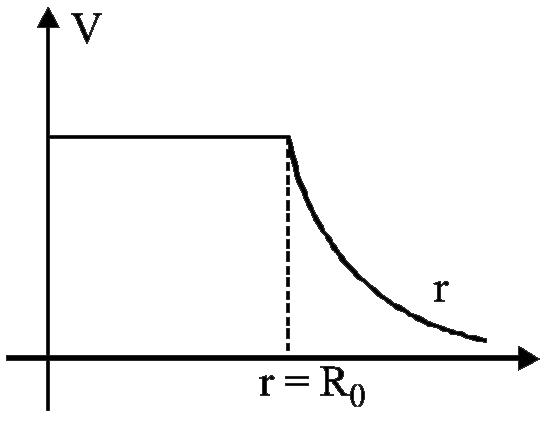Electric potential due to a dipole at a position →r from its centre is: where (K=14πε0
K→p.→rr3
K.→p.→rr2
K.→P×→rr3
K.→p×→rr2
The correct Answer is:A
To find the electric potential V due to a dipole at a position →r from its center, we can follow these steps:
Step 1: Understand the Dipole Configuration
A dipole consists of two equal and opposite charges, +q and −q, separated by a distance 2a. The dipole moment →p is defined as:
→p=q⋅2a
Step 2: Define the Position
Let’s denote the position from the center of the dipole to the point where we want to calculate the potential as r. The distance from the positive charge to the point is r−a and from the negative charge to the point is r+a.
Step 3: Calculate the Potential Due to Each Charge
The electric potential V at a point due to a point charge is given by:
V=Kqr
where K=14πϵ0.
1. Potential due to the positive charge +q at distance r−a:
V1=Kqr−a
2. Potential due to the negative charge −q at distance r+a:
V2=−Kqr+a
Step 4: Total Potential at Point A
The total electric potential V at point A is the sum of the potentials due to both charges:
V=V1+V2=Kqr−a−Kqr+a
Step 5: Simplify the Expression
Factoring out Kq:
V=Kq(1r−a−1r+a)
To combine the fractions, find a common denominator:
V=Kq((r+a)−(r−a)(r−a)(r+a))=Kq(2ar2−a2)
Step 6: Relate to Dipole Moment
Since p=q⋅2a, we can express 2a as pq:
V=Kpr2(for r≫a)
Final Result
Thus, the electric potential V due to a dipole at a distance r from its center is given by:
V=−Kp⋅cosθr2
where θ is the angle between the dipole moment and the line joining the dipole to the point where the potential is being calculated.
A dipole consists of two equal and opposite charges, +q and −q, separated by a distance 2a. The dipole moment →p is defined as:
→p=q⋅2a
Let’s denote the position from the center of the dipole to the point where we want to calculate the potential as r. The distance from the positive charge to the point is r−a and from the negative charge to the point is r+a.
The electric potential V at a point due to a point charge is given by:
V=Kqr
where K=14πϵ0.
V1=Kqr−a
V2=−Kqr+a
The total electric potential V at point A is the sum of the potentials due to both charges:
V=V1+V2=Kqr−a−Kqr+a
Factoring out Kq:
V=Kq(1r−a−1r+a)
To combine the fractions, find a common denominator:
V=Kq((r+a)−(r−a)(r−a)(r+a))=Kq(2ar2−a2)
Since p=q⋅2a, we can express 2a as pq:
V=Kpr2(for r≫a)
Thus, the electric potential V due to a dipole at a distance r from its center is given by:
V=−Kp⋅cosθr2
where θ is the angle between the dipole moment and the line joining the dipole to the point where the potential is being calculated.
Topper's Solved these Questions
Similar Questions
A short electric dipole has dipole moment of 16 x 10^-9 C m. The electric potential due to dipole at a point at a distance of 0.6m from centre of dipole situated on aline making an angle of 60 degrees with dipole axis:
View SolutionThe electric field due to an electric dipole at a distance r from its centre in axial position is E. If the dipole is rotated through an angle of 90∘ about its perpendicular axis, the electric field at the same point will be
View SolutionA short electric dipole is situated at the origin of coordinate axis with its axis along x-axis and equator along y-axis. It is found that the magnitudes of the electric intensity and electric potential due to the dipole are equal at a point distance r=√5m from origin. Find the position vector of the point in first quadrant.
View SolutionFor spherical symmetrical charge distribution, variation of electric potential with distance from centre is given in diagram Given that : V=q4πε0R0 for r≤R0andV=q4πε0r for r≥R0
Then which option (s) are correct :
(1) Total charge within 2R0 is q
(2) Total electrosstatic energy for r≤R0 is non-zero
(3) At r=R0 electric field is discontinuous
(4) There will be no charge anywhere except at r<R0

View SolutionElectric potential V due to a short dipole is related to the distance r of the observation point as
View Solution(a) Derive an expression for the elecrtric field E due to a dipole of length '2a at a point
distant r from the centre of the dipole on the axial line.
(b) Draw a graph of E versus r for r >>a.
(c) If the diploe were kept in a uniform external electric fields E0 Diagrammatically represent
the position of the dipole in stable and unstable equilibrium and write the expressions
for the torque acting on the dipole in both the cases.
View SolutionA ring of radius 3 m has charge density λ. Electric potential at 4 m from its centre on its axis is ____ [k=14πε0]
View Solution(i) Derive the expression for the specific for the electric potential due to an electric dipole at a point on its axial line.
(ii) Depiet the equivpotential surfaces due to an electric dipole.
View SolutionA conducting sphere A of radius a, with charge Q, is placed concentrically inside a conducting shell B of radius b. B is earthed. C is the common center of AandB. Study the following statements.
(i) The potential at a distance r from C, where
a≤r≤b,is14πε0(qr)
(ii) The potential difference between AandB is
14πε0Q(1r−1B)
(iii) The potential at a distance romC, where
a≤r≤b,is14πε0Q(1r−1B)
Which of the following statements are correct ?
 .
.
View SolutionIn th electric potential on the axis of an electric dipole at a distance 'r' from it is V, then the potential at a point on its equatorial line at the same distance away frornt it will be
View Solution
